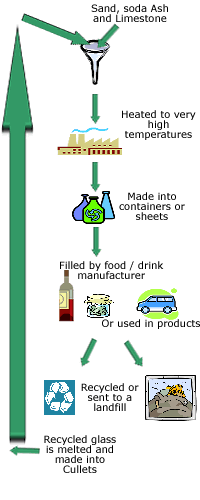What is Glass Recycling?
Glass recycling is one of the most efficient recycling operations there is. Glass is a very recyclable material and doing so saves money and resources.
The UK has a poor record of glass recycling which is a wasted opportunity. Glass that is not recycled will lie in a landfill site forever. It is inert, so although the resource is being wasted, there should be no further damage to the environment.
What is involved in the recycling process, what is the glass eventually made into and how much do we recycle?
The Recycling Process
Glass can be recycled indefinitely forever without loss of quality. All that is required is to heat the glass so that it melts and combine it with ‘virgin’ glass.
The diagram shows the main stages of the process from making new glass through to recycling it. Cullet is the name given to glass when it has been processed ready for recycling.

It should be noted that before the cullet is made, it is separated into different colours, normally clear, green and brown.
Re-using Glass
As well as melting it down and making it into other glass products, glass bottles can also be re-filled. It used to be commonplace to have bottles collected and then sent to the factory to be sterilised and refilled, particularly for milk. This is not so common now mainly because the producers of the food or drink are located far from the people buying the products. It is therefore inefficient to transport the empty bottles to be refilled. However, it is efficient if the market is close to the factory.
What is Recycled Glass used for?
The majority of glass goes back into making more containers and sheets.
Other products can also be made from recycled glass:
• Fibre Glass
• Brick and clay manufacture
• Specialist products such as light bulbs, TV sets and computer screens
• Decorative glass and glassware
• Water Filtration
• Used for shot blasting
Recycling Glass in the UK
The UK has a poor record of glass recycling compared with other European countries. In 2002, only 34% of glass consumed in the UK was recycled. However, government targets have resulted in progress and in 2004 this figure had risen to 46%. The target is to achieve 71%.
There are 2 main stumbling blocks:
1. Collection – there are few but a growing number of kerbside collections. This means that the majority of collection is reliant on people taking their glass to bottle banks. More kerbside collections would make it easier for consumers and less glass would be thrown in the bin and ending up in landfills.
2. Colour – The UK produces mainly clear glass for packaging products. However consumers buy many imported glass, much of it wine in green bottles. This means that there is too much green glass collected than demand – this is often transported on to mainland Europe. There is not enough clear glass required for UK products currently being recycled. This could be boosted if less clear glass was thrown out meaning there would be less demand for ‘virgin’ glass.
- Home ›
- Glass ›
- Glass Recycling


